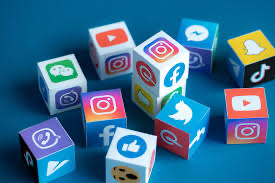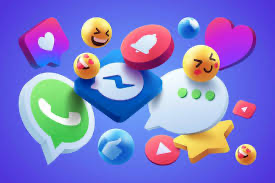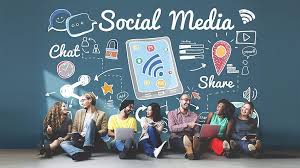Social media is the latest development in the Internet which has been accompanied by the emergence of many Web 2.0 technologies. In general, many specialists in Internet science point out that social media represents a great leap to communicate through the Internet in a much more interactive way than before, when communication was limited to sharing very small amounts of information and greater control of data managers.
Social media also provided many opportunities, some of which may be a place for trading for some companies and the beginning of all projects, and some of them may support small projects as well, the sharing of information between all subscribers of the network with the possibilities of direct and free interaction on social sites and at the end of each article or news, and it also provided the opportunity for recipients to make their programs radio or television that they like and follow by putting forward proposals to the programmer, or participating by asking questions to the guest who will be hosted in the program, all of this and what social media has done with the revolutions that swept the Middle East and the protests that swept many European countries and America is considered a new addition as these events were made The so-called citizen journalist, so the person who lives the events became able to photograph or write about them and send what he photographed or wrote to the media eager for news from areas that the correspondents of those means could not enter, either because of the ruling regime’s fear of the world knowing what is happening or because of the difficulty of accessing the event that might Its time exceeds only minutes, so it was not possible to transfer it to the world except through those who lived with it and documented it.
The term social media refers to the use of Internet technologies and mobile (telephone) technologies to transform communications into interactive dialogue. Andreas Kaplan and Michael Hanlin define social media as “a set of Internet applications that build on the ideological and technological foundations of Web 2, and that allow the creation and exchange of user-generated content.” Social media is media for social communication as the umbrella group behind social communication.
Social media technology takes many forms including magazines, internet forums, social blogs, microblogs, wikis, social networks, podcasts, images, videos, and social bookmarking. Their technology includes blogging, photo sharing, vlogging, music sharing and VoIP, to name a few. Social networks can link many of the programs used.
Mobile social media refers to a combination of mobile devices and social media. It is a set of mobile marketing applications that allow the creation and sharing of user-generated content. Due to the fact that mobile social media runs on mobile devices, it differs from traditional social media by the inclusion of new factors such as the user’s current location (location property) or the time delay between sending and receiving messages (time property). According to Andreas Kaplan Andreas Kaplan, mobile social media applications may vary into four types:
1.Spacetimer (significance of location and time): Exchange messages with their importance to a specific place at a specific point in time (eg: Facebook).
2. Spatial timer (location importance): Exchange of messages, with relevance to a particular location, which are flagged in a certain place, and read at a later time by others (Example: Yelp Qype)
3. Quick Timer (Time Matters): Moving traditional social media apps to mobile devices to increase immediacy (such as posting Twitter or Facebook messages and status updates).
4. The slow timer (doesn’t care about place or time) Transfer traditional social media apps to mobile devices
There is a growing trend towards the use of social media monitoring tools that allow marketers to search, track and analyze online conversation and find news about their brand, or about topics of interest. This can be useful in managing public relations, allowing the user to measure revenue from Investment, competitor audits, and general public participation. The tools range from basic apps for free, to more in-depth, subscription-based tools.
Criticisms of social media are the ease of use of specific approaches and capabilities, the variance in available information, issues regarding the credibility and reliability of the information provided, the influence of social media use on individual focus, ownership of media content, and the meaning of interactions generated by social media.Although some media platforms Social media provides users with the opportunity to participate simultaneously, and some social network platforms have been criticized for the lack of compatibility and sharing between other media platforms, which has led to the creation of information stores and the isolation of data contained in one media platform. However, there are those who say that social media has positive effects Like allowing democracy on the internet while allowing people to advertise themselves and make friends. Due to the increase in social media sites, there appears to be a positive correlation between the use of these media (cyberbullying is the phenomenon of cyberbullying of a specific person), sexual monsters, and decreases in face-to-face interaction. Also, social media may expose children to images of alcohol, tobacco, and sexual behaviors.
This is in addition to the political employment of social networking sites
Effects on interpersonal relationships
The data shows that participants who use social media only to fulfill their perceived social needs, but are usually disappointed. Lonely individuals go online for emotional support. This causes problems because it interferes with “real-world social life”. Some of these views are summarized in Stephen Marche’s Atlantic article, “Has Facebook Made Us Lonely?” Markey says social media allows more breadth, but not depth of relationships that humans need. Although he makes interesting points about social media and how it replaces face-to-face interaction, he fails to cite some of his sources.
Of the positive effects of social media and internet based social networks. According to the authors, social media is used to document memories, learn and explore things, advertise oneself and form friendships. For example, they claim that communication through web-based services is more private than what happens in real life. Furthermore, Rainey and Wellman argue that everyone has the potential to become a content creator. Thus, creating content provides individuals with opportunities to reach a wider audience. Moreover, it can positively influence their social status and gain political support. This can lead to influencing issues of concern to the person. As a concrete example of the positive effects of social media, the authors use the Egyptian revolution in 2011, where people use Facebook to hold meetings and many other things.
Facebook represents a tool that can be useful in educational contexts. It allows both synchronous and asynchronous, initiating an open dialogue via a known medium and accessing it regularly, and supports the integration of multimedia content such as made by students pictures, videos and URLs into other texts of students who already have knowledge of it. Moreover, it allows students who are not motivated To visit the professor during business hours by asking and asking more simple questions. It also allows students to manage their own privacy settings, often working with privacy settings already established as a registered user.
Twitter also enhances social connections among students. It can be used to enhance connection building and critical thinking. Domise (2013) uses Twitter in a graduate seminar and asks students to post a tweet on a weekly basis to extend class discussions. Using Twitter benefits students to view content and to communicate with other students. In addition, students found it to be “professionally and personally useful.” Junco, Heibergert, and Loken (2011) completed a study of 132 students on the relationship between social media, student engagement, social media, and grades. They divided the students into two groups, one that used Twitter and the other that did not. Twitter was used to discuss materials, organize study groups, post class announcements, and communicate with colleagues. Junko et al. (2011) found that students in the Twitter group had higher rates of higher engagement, more point accumulating, and control over the group. Gao, Luo, and Zhang (2012) reviewed the literature on Twitter between 2008 and 2011 and concluded that Twitter allows students to engage with each other in class, and expand discussion outside of class. They also reported that students use Twitter to get the latest news and connect with professionals in the field. Students reported that microblogging encouraged them to “share at a higher level” because posts cannot exceed 140 characters, and students are required to express ideas that reflect and focus on important concepts in a concise manner. Some students have found this to be of great benefit. Other students didn’t like being restricted to a specific character limit. Also, some students found microblogging to be interesting and prominent. The research indicated that many students did not actually participate in the discussions, “they are just observers.”
YouTube is the most used social media tool in the classroom. Students can watch videos, answer questions, and discuss content. In addition, students can create videos to share with others. Sherer and Shea (2011) claimed that YouTube has engagement, personalization, and productivity. YouTube also improved students’ digital skills and provided the opportunity for peer learning and problem solving and in 2012 found that videos maintained Students’ attention, generated interest in the topic, and became the course content.In addition, students reported that the videos helped them recall information and conceptualize real-world applications and, of course, concepts.
Instagram is a free photo-sharing application and a social network as well. It was launched in October 2010 and is currently acquired by Facebook. It allows users to take a photo, add a digital filter to it, and then share it on a variety of social networking services and the Instagram network itself.
Instagram was initially supported on the iPhone, iPad and iPod touch, and in April 2012 it was made available on the Android Froyo platform (2.2), distributed via the iTunes Store and Google Play, and in June 2013 the time-lapse video application was developed for users.




